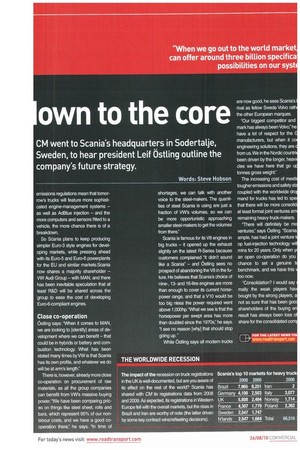Gettin own to the core
Page 16

Page 17

If you've noticed an error in this article please click here to report it so we can fix it.
SCANIA HAS BUILT a reputation for making tough, reliable trucks, but the company is now as much about its service organisation as vehicle manufacturing. President Leif Ostling ex plains: "Fleet operators have become more focused on their business, which is transport — equipment. people and logistics — and they outsource more and more of what is not core to that business — servicing, finance, insurance, etc It is the same as what we are doing — we outsource what is not core to us:' While ()sting is vague on what will be "core" for Scania in future, he is clear that the manufacturing of major components, such as engines, and gearboxes, will remain in-house.
"It's about defining whether an activity is core or strategic. In the core activities, Scania should manage the process, perform the work and secure the assets needed. In strategic activities, Searle should manage the process but not necessarily employ all of the workforce or own the assets," he explains.
To simplify both manufacturing and servicing of its vehicles, Scam has adopted a modular approach to powertrain design, with just 20 engine variants, 11 gearbox and nine axle options across its 230hp to 730hp power range Ostling is confident this will enable the company to deliver vehicles suitable for its global market.
"If we produce 100,000 trucks in a year, we turn out about 90,000 different specifications, so each truck is specified to the customer's needs. To meet that variation in specification. we need to de velop a smart modular system. When we go out to the world market, we can offer around three billion specification possibilities on our system:' he says. Increasingly stringent US and EU emissions regulations mean that tomorrows trucks will feature more sophisticated engine-management systems — as well as AdBlue injection — and the more computers and sensors fitted to a vehicle, the more chance there is of a breakdown.
So Scene plans to keep producing simpler Euro-3 style engines for developing markets, while pressing ahead with its Euro-5 and Euro-6 powerplants for the EU and similar markets Scene now shares a majority shareholder — VW Audi Group — with MAN, and there has been inevitable speculation that at least R&D will be shared across the group to ease the cost of developing Euro-6-compliant engines.
Close co-operation Ostling says. "When it comes to MAN, we are looking to [identify] areas of development where we can benefit — that could be in hybrids or battery and combustion technology. What has been stated many times by VW is that Scania has its own profile, and whatever we do will be at arm's length,
There is, however, already more close co-operation on procurement of raw materials, as all the group companies can benefit from VW's massive buying power. "We have been comparing prices on things like steel sheet, rolls and bars, which represent 95% of our nonlabour costs. and we have a good cooperation there," he says. "In time of shortages, we can talk with another voice to the steel-makers. The quantities of steel Scania is using are just a fraction of VW's volumes, so we can be more opportunistic approaching smaller steel-makers to get the volumes from there.'
Scania is famous for its V8 engines in big trucks — it opened up the exhaust slightly on the latest R-Series because customers complained "it didn't sound like a Scene" — and Ostling sees no prospect of abandoning the V8 in the future. He believes that Scania's choice of nine-, 13and 16-litre engines are more than enough to cover its current horsepower range, and that a V10 would be too big nless the power required went above 1.000hp "What we see is that the horsepower per swept area has more than doubled since the 1970s.• he says. "I see no reason [why] that should stop going up."
While Ostling says all modern trucks are now good, he sees Scania's rival as fellow Swede Volvo rath the other European marques.
'Our biggest competitor and mark has always been Volvo," he have a lot of respect for the manufacturers, but when it co engineering solutions, they are from us. We in the Nordic countri been driven by the longer, heavi des we have here that go u tonnes gross weight."
The increasing cost of meeti tougher emissions and safety st coupled with the worldwide dro mand for trucks has led to spe that there will be more consolid at least formal joint ventures am remaining heavy truck-makers.
"There will definitely be m ventures." says Ostling. "Scania ample. has had a joint venture t op fuel-injection technology wi mins for 20 years. Only when an open co-operation do you chance to set a genuine t benchmark, and we have this too now.
-Consolidation? I would say malty the weak players hay bought by the strong players. a not so sure that has been goo shareholders of the buying en result has always been loss o share for the consolidated corn




























































































































